Woodbury (post 1940)
Continued from: Woodbury (1910-1940)
Like many other American cosmetic companies, Woodbury was forced to make a number of changes to comply with the Wheeler-Lea Act, and the Food, Drug, and Cosmetic Act, both passed in 1938. The cosmetic provisions of the legislation introduced new labelling and packaging standards, and placed restrictions on the claims that companies could make, particularly those associated with nourishing, feeding, rejuvenating or revitalising the skin.
See also: The FDA, FTC and Cosmetics
Woodbury’s assertion that Vitamin D was readily absorbed by the skin was questioned as were its ‘germ-free’ and ‘germ-proof’ claims. The vitamin D problem was eventually settled in the courts and Woodbury got around the ‘germ-free’ and ‘germ-proof’ problems by reducing its earlier claims. However, it began to advertise that its creams contained Stericin to help purify them against blemish-causing germs and continued to do so through to 1948.
Skin-care
Woodbury Tissue Cream, like other cosmetics that suggested they had a nutrient value, had to be abandoned because of the legislation. Woodbury changed its name to Woodbury Dry Skin Cream in 1940, but added ‘Formerly Tissue Cream’ to the label.
Dry Skin Cream: “[G]erm-free. Helps dryness and harshness beat a quick retreat, leaves skin soft as cream. Apply at Bedtime. Leave on overnight.”
See also: Skin Foods
The addition of Woodbury Dry Skin Cream required Woodbury to change the way it labelled its Cold Cream. The phrase ‘For Normal or Dry Skin’, previously on the label, was changed to ‘Cleanses, Softens, Smooths’ late in 1941.
More drastic labelling changes were made during the war in 1944. Woodbury Cold Cream became Woodbury Complete Beauty Cream; Cleansing Cream became Oily Skin Cleansing Cream; Dry Skin Cream became Special Dry Skin Cream; Foundation Cream became Creampuff Powder Base; and Facial Cream became Protective Make-up Film.
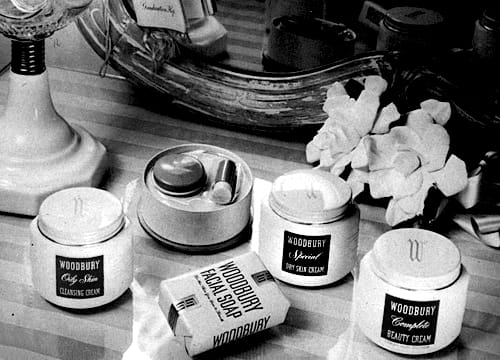
Above: 1945 Assorted Woodbury products.
The name changes extended to the labels which were enlarged allowing the use of larger, more legible text.
Make-up
In 1940, Woodbury introduced Woodbury Foundation Cream, a flesh-coloured cream that was most likely a tinted version of Woodbury Facial (Vanishing) Cream. Like the Facial Cream it was also used as a powder base.
Woodbury Foundation Cream: “It smooths, protects, gives make-up clean-cut charm.”
When the Foundation Cream arrived, Woodbury’s face powder came in eight shades – Flesh, Natural, Rachel, Radiant, Brunette, Windsor Rose, Champagne, and Blush Rose – and its lipstick and rouge came in six – Natural, Flame, Raspberry, Poppy, Blush Rose, and Burgundy.
In 1941, Woodbury introduced its Color Controlled Powder in six shades packaged in a new powder box with a Greco-roman woman on the lid.
Color Controlled Powder: “[D]oes away with tiny blobs of colour. And color control makes Woodbury fine, soft, clinging for hours.” Shades: Flesh, Rachel, Brunette, Windsor Rose, Champagne, and Blush Rose.
To help women select an appropriate shade of powder, Woodbury divided women into five skin types, using a movie star linked to a shade of powder to represent each type. This approach was not new. The idea of using movie stars as types went back to the early 1930s.

Above: Woodbury five skin type. Merle Oberon [1911-1979] represented the Ivory skin Type, Virginia Bruce [1910-1982], the Cameo Skin Type, Brenda Joyce [1917-2009] the Honey Skin Type, Delores del Rio [1904-1983], the Tropic Skin Type, and Myrna Loy [1905-1993], the American Beauty Blend.
Honey-Skin Blonde: Champagne or Windsor Rose powder.
Ivory-Skin Brunette: Rachel or Blush Rose powder.
Tropic-Skin Brunette: Brunette or Champagne powder.
Cameo-Skin Blonde: Flesh or Blush Rose powder.
American Beauty Blend: Windsor Rose or Brunette powder.
See also: Make-up, Personality and Types
Having established the five skin types, Woodbury produced Matched Make-up Kits for each type, each kit containing a box of Color Controlled Powder with a suitable Woodbury Lipstick and Rouge.
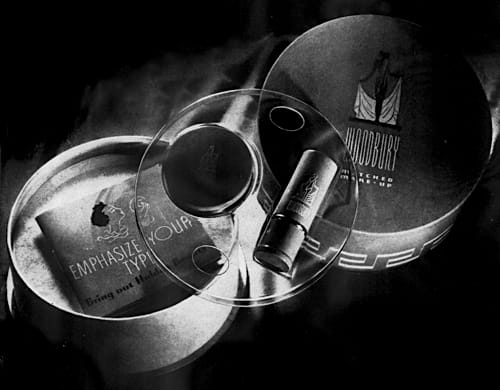
Above: 1942 Woodbury Matched Make-up Kit.
Some modifications to this arrangement were made during the war. In 1942, Woodbury replaced the Rachel and Tan shades with Champagne Rachel and Tropic Tan, and added Sun Peach.
Post War
Woodbury found business conditions more difficult after the Second World War. As a budget brand it did better in the adverse economic situation of the 1930s than in the post-war prosperity of the 1950s.
One limiting factor was television. Woodbury had used radio advertising quite effectively during the 1930s but most of its products did not have the margins or sales to justify the expense of using television. When it did so in the 1960s it was for its higher volume products like soaps and shampoos.
The depth of its product line was another factor, particularly when it came to make-up. Most cosmetic companies sold a complete range of make-up but Woodbury only produced face powders, foundations, lipsticks and rouges, a situation that persisted until the 1960s.
A third problem was Woodbury reliance on film stars, particularly to promote its make-up. Like Max Factor and Westmores, Woodbury sales suffered when cheap film star endorsements dried up in the 1950s following the collapse of the Hollywood studio system.
See also: Max Factor (1945-1960) and House of Westmore
In 1948, Woodbury completed the repackaged of its entire product line. This had started in 1947 with the introduction of the new ‘Venus’ powder box which used an image based on ‘The birth of Venus’ by the Florentine painter Sandro Botticelli [1445-1510].
Changes to the soap packaging were minor with the company retaining ‘A skin your love to touch’ on the wrapper.
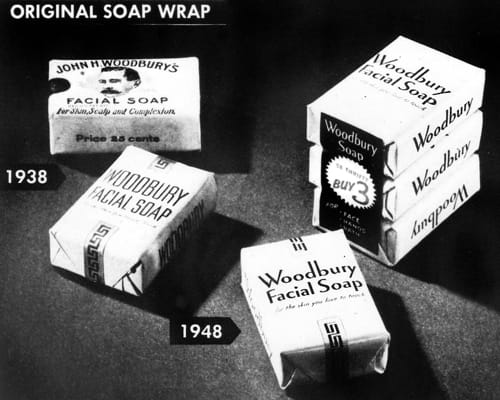
Above: 1948 Woodbury Facial soap in old and new packaging.
Woodbury skin creams were rehoused in swirled-rope jars that were oval in shape to prevent rolling. The new labels were originally designed to be different colours to help with product recognition but this idea was scrapped and all the labels were printed in pink and gold when the De Luxe range was introduced in 1949.
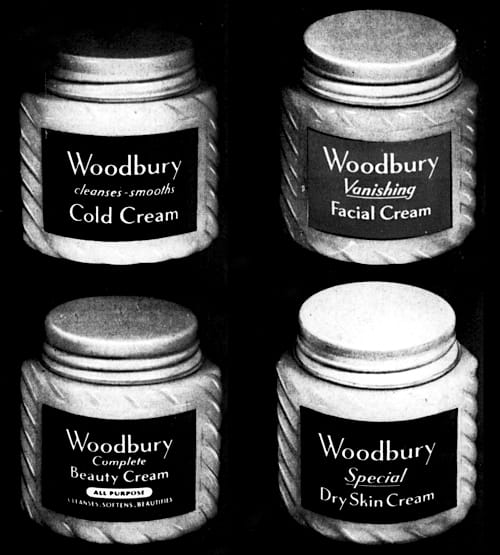
Above: 1948 Woodbury skin creams in new jars.
Changes to the Woodbury lipsticks and rouges saw the older enamelled cases giving way to new cases of polished metal.
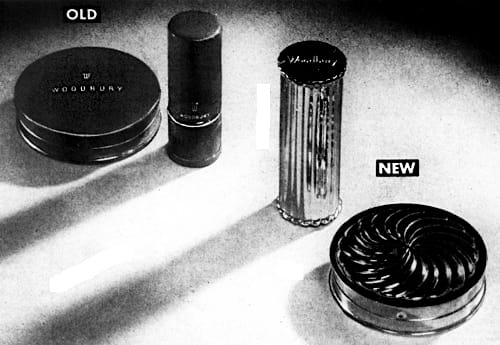
Above: 1948 Woodbury Lipstick and rouge in old and new packaging.
The packaging of Woodbury’s range of men’s toiletries – Lather Shave Cream, After Shave Lotion, and After Shave Talc – were embellished with gamecocks and some products were given horizontal lettering to make them more readable.
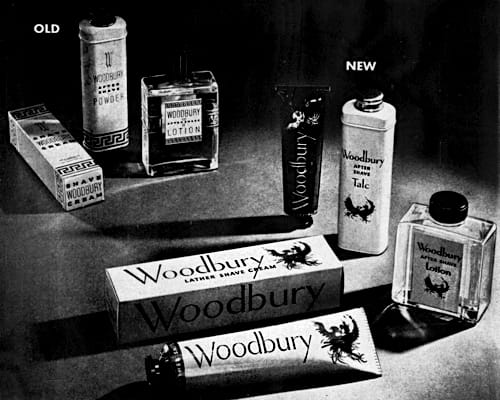
Above: 1948 Woodbury Lather Shave Cream, After Shave Lotion, and After Shave Talc in old and new packaging.
Soap
Woodbury soap got an additional refit in the 1953 with another new package, a new Bridal Flower fragrance, and a change in the soap colour to Sea Spray Green. It was later also produced in Dreamy Pink and Creamy White.
A further development occurred in 1956, when the company introduced Woodbury Beauty and Deodorant Soap with the germicidal agent XL-7, the company’s name for Bithional (4,6-dichlorophenol), a germicidal also used in the medicated pimple cream, Clearasil (Drug and Cosmetic Industry, May, 1957, p. 668). It joined a long list of new deodorant soaps that followed the success of Dial soap (1948), containing the germicidal agent hexachlorophene.
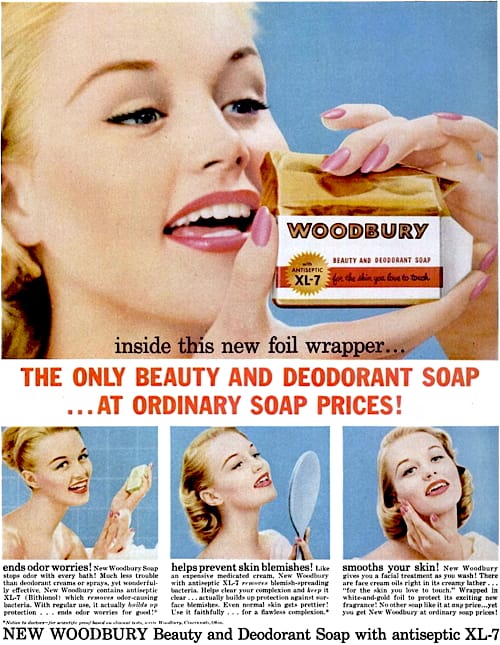
Above: 1956 Woodbury Beauty and Deodorant Soap with XL-7.
See also: Hexachlorophene
Skin-care
In 1947, Woodbury replaced its older Woodbury Lotion, a hand cream, with Woodbury Beauty-Blended Lotion. Described as a 2-lotion-in-1 because it softened as well as protected the hands, the pale cream lotion was formulated with ‘luxury lanolin’. As far as I can tell, this was the first time Woodbury had mentioned this ingredient.
Beauty-Blended Lotion: “[S]o peaches-and-cream rich . . . feels so luscious on your skin. Never sticky or greasy. Exquisitely fragrant.”
Skin creams
In 1948, Woodbury introduced its previously mentioned De Luxe Face Cream range in the new swirled-rope, oval jars with pink lids, and pink and gold labels. Most of the creams were formulated with the proprietary ingredient Penaten, said to help the creams ‘penetrate deeper into pore openings’. With the exception of the De Luxe Liquefying Cleansing Cream, all these creams had existed in some form before the war.
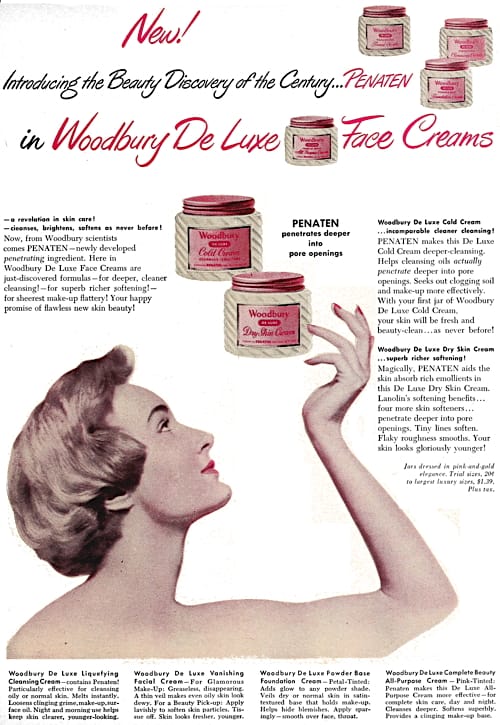
Above: 1949 Woodbury De Luxe Creams.
De Luxe Cold Cream: “Frees hard to remove make-up, clinging soil. Smooths more effectively . . . Penaten carries Woodbury’s rich skin softeners deeper.”
De Luxe Dry Skin Cream: “Magically Penaten aids the penetration of smoothing emollients. Carries lanolin’s rich benefits deeper, softening tiny dry lines. Smooths flaky roughness—on the instant. Skin looks fresher, younger . . . lovely to see!”
De Luxe Liquefying Cleansing Cream: “[C]ontains Penaten! Particularly effective for cleansing oily or normal skin. Melts intently. Loosens clinging frame, make-up, surface oil. Night and morning use helps keep skin clearer, younger-looking.”
De Luxe Vanishing Facial Cream: “For glamorous make-up. Greaseless, disappearing. A thin veil makes even oily skin look dewy.”
De Luxe Powder Base Foundation Cream: “Petal-Tinted: adds glow to any powder shade. Veils dry or normal skin in satin-textured base that holds make-up. Helps hide blemishes.”
De Luxe Complete Beauty All-Purpose Cream: “Pink-Tinted: Penaten makes this … more effective—for complete skin care, day an night. Cleanses deeper. Softens superbly. Provides a clinging make-up base.”
The De Luxe label disappeared from Woodbury skin creams after 1953 and I know of no further skin-care developments until Woodbury added Deep Dew, a moisturiser, in 1959. Deep Dew appears to have been a response to the work done by Irvin H. Blank [1902-2000] and others earlier in the decade. However, like most moisturisers introduced in the late 1950s, it did not give up on the idea that moisture was required to reach deep in the skin.
Deep Dew: “[A]n exclusive blend of two precious humectants, plus lanolin to help the moisture penetrate!”
See also: Moisturisers
Make-up
In 1945, Woodbury doubled down on its use of film stars by reformulating/renaming its face powder as Film-Finish in eight star-styled shades.
Film-Finish Powder: “5-way blending gives lovliest-ever color . . . smoothest-ever texture. … [C]lings longer, hides blemishes best ever. Never clogs or turns pasty.” Shades: Flesh, Rachel, Brunette, Windsor Rose, Blush Rose, Champagne Rachel, Tropic Tan, and Sun Peach, with Fiesta added in 1947.
Film-Finish Power continued too be sold in the Matched Make-up Kits first introduced in 1941 but these appear to have disappeared by 1948 following the introduction of the ‘Venus’ box in 1947. Woodbury then referred to its face powders simply as Woodbury Powder but reformulated it, changed its fragrance and reduced its shade range to six.
Woodbury Powder: “Gives a smooth-as-satin -finish to skin (a finish never possible with powder alone before!) . . see that Woodbury covers tiny blemishes amazingly . . . yet gives the natural ‘unpowdery look’ that you and Hollywood adore!” Shades included: Natural, Rachel, Brunette, Fiesta, and Tropic Tan with Coquette added in 1950.
Tinted Cream Make-up, later known more simply as Cream Make-up, followed. This powder cream could be used alone but was primarily developed as a powder foundation. It was refillable and only came in three shades.
Tinted Cream Make-up: “A combination of foundation-plus- powder, it, alone, gives young faces a fresh, radiant glow. With a touch of powder, it gives that ‘finished’ look.” Shades: Natural, Brunette, and Tropic Tan. Coquette added in 1950.
A third new make-up item that arrived in the late 1940s was Dream Stuff (1949) in four ‘dream’ shades. Designed as an all-in-one foundation and powder it was originally sold in a vanity box but a plastic compact version arrived in 1952. This compact was redesigned in 1955 in a more conventional ivory and gold plastic case with mirror and puff.
Dream Stuff: “Not a drying cake or greasy cream! Dream Stuff is the new, all-in-one dream make-up that smooths on in a flash . . . instantly does the work of tinted foundation and powder both!” Shades: Pretty Dream, Rosy Dream, Golden Dream, and Tropic Dream. Later shades included Gay Dream (1950), and Sunny Cream (1951).
In 1951, Woodbury added Woodbury Liquid Make-up. This could be used in isolation or powdered down with Woodbury Powder. By 1955, it was repackaged in a plastic squeeze bottle and renamed as Make-up Glow, becoming Dream Glo make-up by 1956.
Woodbury Liquid Make-up: “[N]atural looking color that smooths, tints and glorifies your skin. Makes any fashion color you choose becoming! Completely wonderful in itself! Or twice as lovely with perfectly matched Woodbury Powders.” Four shades including Fiesta.
Dream Glo
By 1957, Woodbury had began referring to its make-up range as Dream Cosmetics, adding Dream to the names of its other forms of make-up by 1958. Cream Make-up (originally called Tinted Cream Make-up) became Dream Glo Cream Make-up, Face Powder was renamed as Dream Glo Face Powder, and Make-up Glow (originally called Liquid Make-up) was now known as Dream Glo Liquid Make-up. These were all formulated with Dreamlite, Woodbury’s ‘beauty discovery that keeps make-up always color-true’.
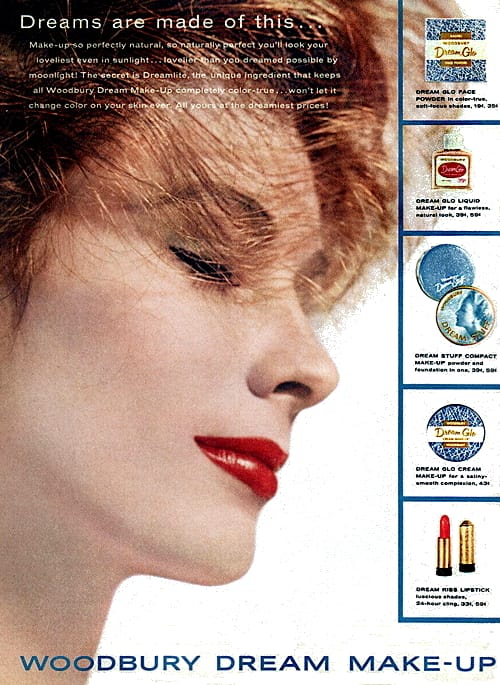
Above: 1958 Woodbury Dream Glo Face Powder, Dream Glo Liquid Make-up, Dream Stuff Compact Make-up, Dream Glo Cream Make-up, and Dream Kiss Lipstick.
In the 1960s, the Dream Glo name was applied across the entire Woodbury make-up range which was extended to include nail polishes and eye make-up, leading to a depreciation of the Woodbury brand name. Although the product packaging improved Dream Glo was well entrenched as a budget brand. Unfortunately, apart from their existence, I have almost no information on the extent of the range or the shades in which it was produced.
End of the line
Dream Glo appears to have been the swansong of the Woodbury range which looks to have disappeared by the 1970s. It was probably discontinued after Andrew Jergens was sold to American Brands in 1970 but this is yet to be confirmed.
Timeline
| 1940 | New Products: Dry Skin Cream; and Foundation Cream. |
| 1941 | New Products: Color Controlled Powder. |
| 1944 | Woodbury creams renamed. |
| 1945 | New Products: Film-Finish Powder. |
| 1947 | New Products: Beauty-Blended Lotion. |
| 1948 | Woodbury range repackaged. |
| 1949 | New Products: Liquifying Cleansing Cream; and Dream Stuff. |
| 1951 | New Products: Liquid Make-up. |
| 1955 | New Products: Deodorant added to Woodbury Facial Soap. |
| 1958 | New Products: Deep Dew. |
| 1969 | Andrew Jergens lists on the New York Stock Exchange. |
| 1970 | Andrew Jergens bought by American Brands. |
First Posted: 1st June 2023
Sources
The American perfumer & essential oil review. (1906-1955). New York: Robbins Perfumer Co. [etc.].
The drug and cosmetic industry. (1932-1997). New York: Harcourt Brace Jovanovich [etc.].
John H. Woodbury, Inc. (c.1941). How to give your skin romantic beauty [Booklet]. Cincinnati, OH: Author.
Woodbury up-to-date. (1948). Modern Packaging. July, 85-93.
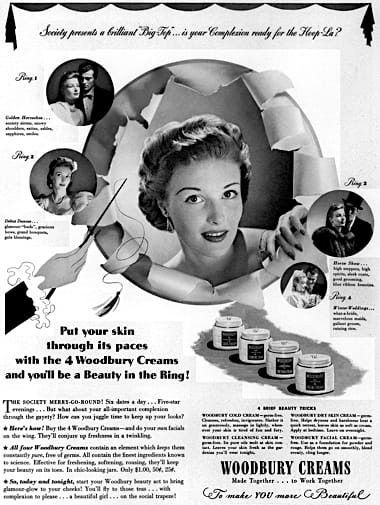
1940 Woodbury Cold Cream, Cleansing Cream, Dry Skin Cream, and Facial Cream.
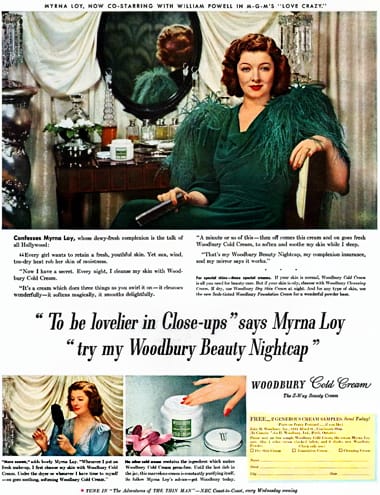
1941 Woodbury Cold Cream.

1941 Woodbury Color Controlled Powder.
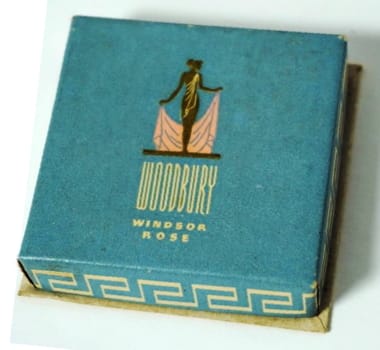
Woodbury Windsor Rose Powder in the ‘Greco-Roman Woman’ box introduced in 1941.
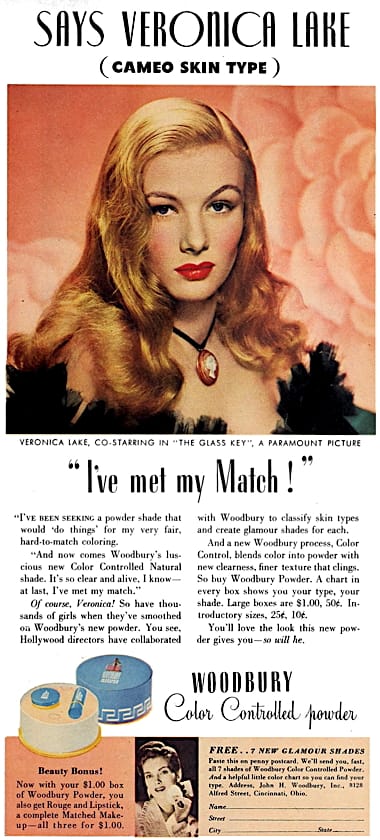
1942 Woodbury Color Controlled Powder.

1946 Woodbury Facial Soap.

1946 Woodbury Film-Finish Powder.
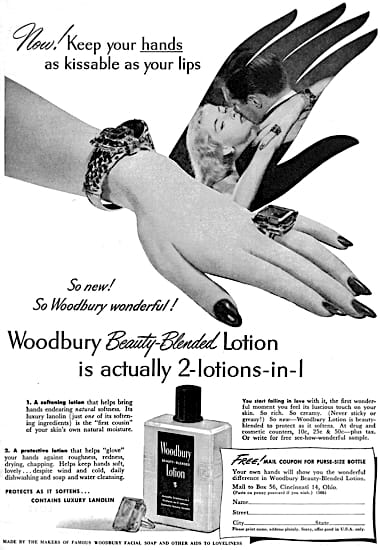
1947 Woodbury Beauty-Blended Lotion.
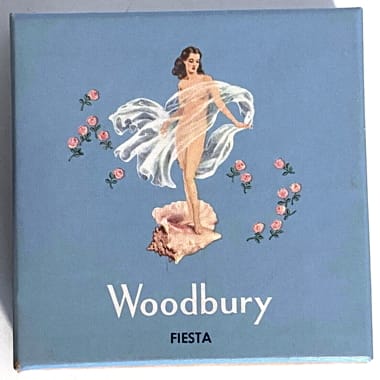
Woodbury Fiesta Powder in the ‘Venus’ box introduced in 1947.
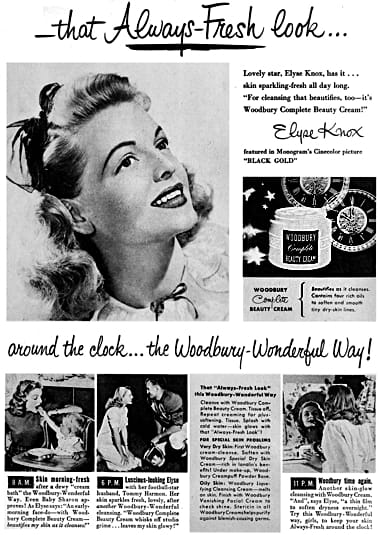
1947 Woodbury Complete Beauty Cream with Stericin.
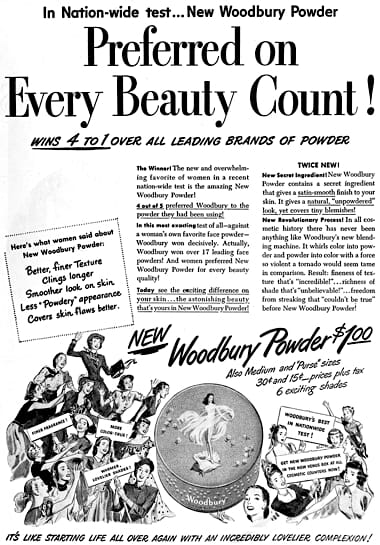
1948 Woodbury Powder.
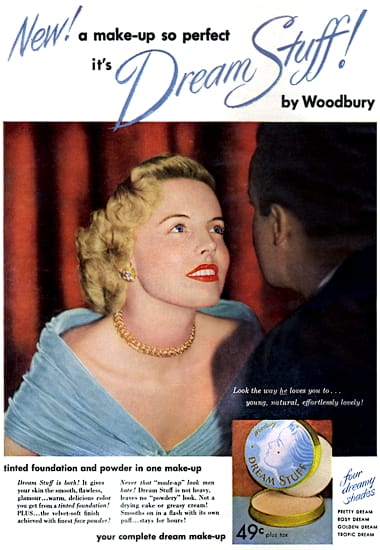
1949 Woodbury Dream Stuff.
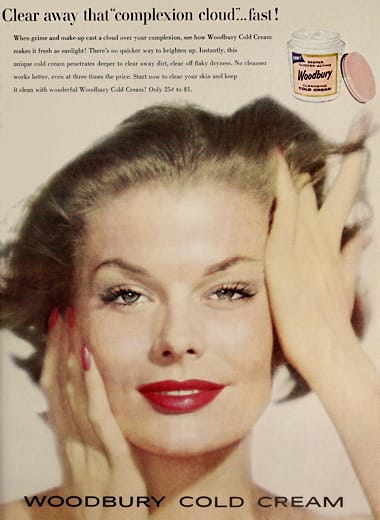
1950 Woodbury Cold Cream.
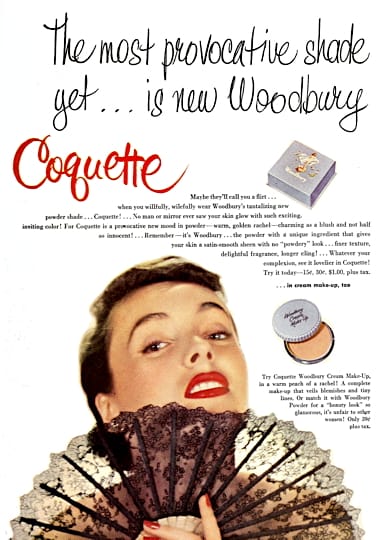
1950 Woodbury Coquette Powder.
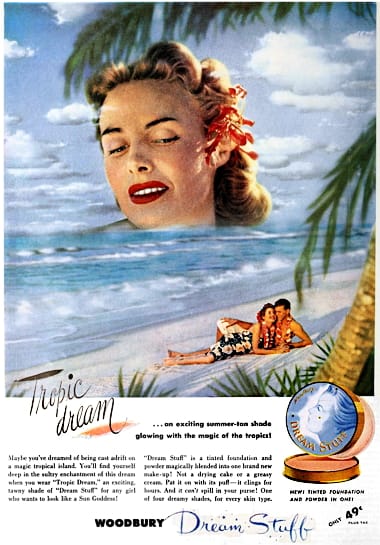
1950 Woodbury Tropic Dream.

1952 Woodbury Dream Stuff in original compact.
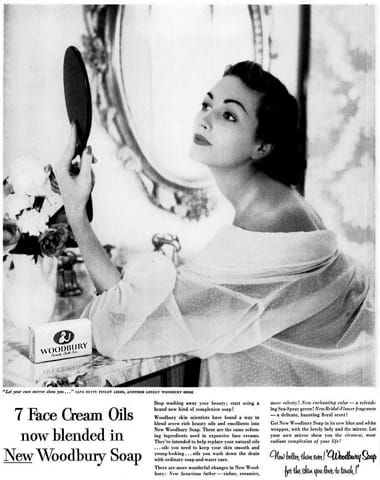
1953 Woodbury Soap.
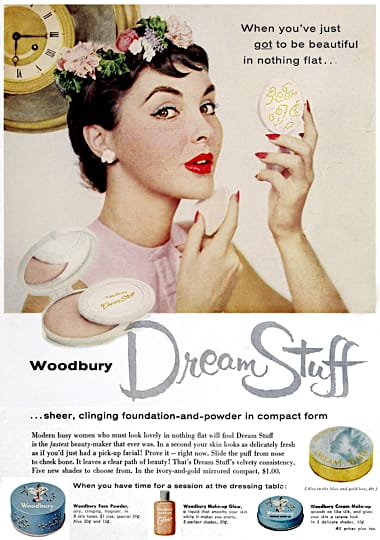
1955 Woodbury Dream Stuff in new ivory and gold mirrored compact.
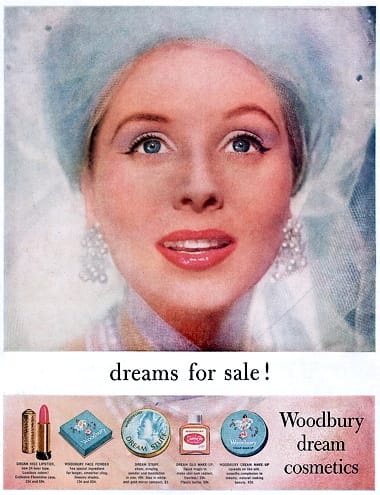
1957 Woodbury Dream Cosmetics.
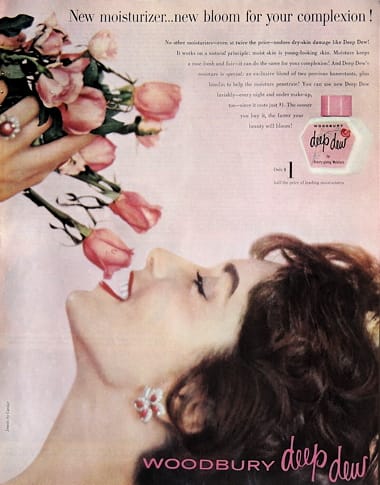
1959 Woodbury Deep Dew.
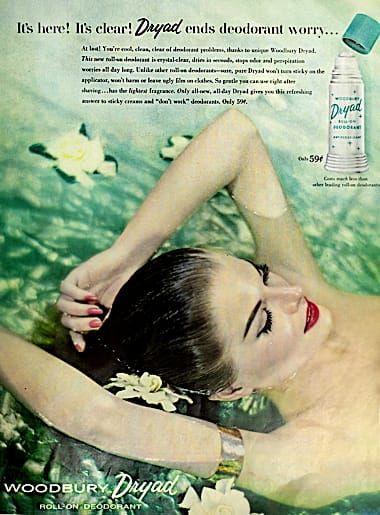
1959 Woodbury Dryad Roll-On Deodorant. Dryad had started out as Andrew Jergens Dryad Cream in 1948.
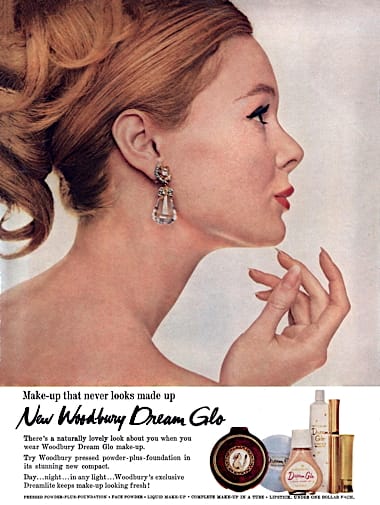
1964 Woodbury Dream Glo. The tortoiseshell compacts came in eight shades: Hint of Peach, Dark Tan, Hint of Rose, Cream Beige, Suntan, Peach Blush, Rose Blush and Translucent.
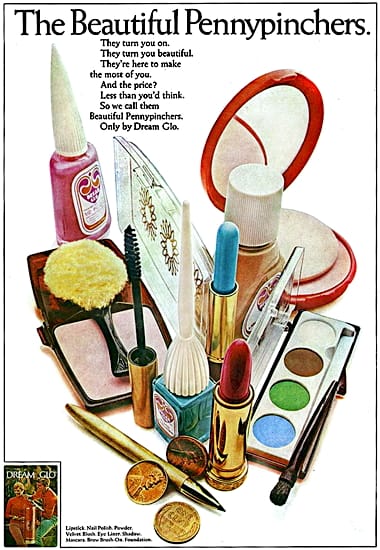
1968 Woodbury Dream Glo.
